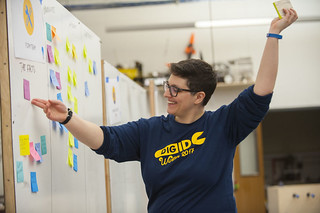No grades, and they cut vacations short:
While many of their fellow students were sleeping in over winter break, 17 SMU students came back to school in January before classes resumed for a “no grades” design project that delivered a design solution they called “ModPod”
DALLAS (SMU) – While many of their fellow students were sleeping in over winter break, 17 SMU students came back to school in January before classes resumed for a “no grades” design project that delivered a design solution they called “ModPod” for sponsoring partners at Better Block Foundation and Good Faith Energy.
The challenge was to design a flat-pack (think about what comes in an assemble-it-yourself box from IKEA) solar charging station that urban dwellers can use for mobile devices like cell phones and laptops. Better Block Foundation uses a human-centered approach to offer consulting, tools and support for the prototyping of initiatives that can help develop more livable neighborhoods, so designing for them means coming up with simple designs that can work on sidewalks and in parks. Good Faith Energy is a North Texas solar energy provider, and the company donated $500 to help cover students’ costs.
As the clock begins to tick, students in these Immersive Design Challenges start brainstorming, designing, building small models and learning to “fail forward.” No worries, though, because learning and adapting from mistakes is part of the process where participants quickly adjust and repeat rapid prototypes to overcome obstacles and drive toward better solutions.
Students self-sort into teams that focus on what they can best contribute – from computer-aided design, to physical construction with traditional power tools, to operation of a 3-D printer, to making the final presentations that “sell” the design to the sponsors. It is this divide-and-conquer approach that draws SMU students from programs and majors all over campus.
The final design that emerged from the January competition is a curvy plywood design that can be snapped together and function as a vertical piece, or a horizontal unit that can be used as a bench. Modular additions can be snapped on to allow the mounting of solar panels, a battery pack, power outlet, even a method for locking your bike and phone. You can watch a time-lapse video of the students assembling the prototype.
ModPod now becomes part of Better Block Foundation’s wikiblock, an open-source toolkit of designs for urban furniture like benches, planters and bus stops that are available for free download. The common denominator for all the wikiblock designs is that parts are crafted out of plywood cut with a computer-assisted router, and most can be assembled without glue or nails “to make a block better.”
“Dream it. Print it. Build it. Live it.” That’s the wikiblock mantra.
Immersive Design Challenges are hosted throughout the year in the Deason Innovation Gym, nicknamed “the DIG,” in SMU’s Bobby B. Lyle School of Engineering. These competitions are a big draw for engineering students, of course, but are open to students from all majors and minors, resulting in the kind of inter-disciplinary teams that successful businesses have learned are the best incubators for good ideas.
Students have to apply for a spot on the team. They don’t earn any class credit, and the participants have to be willing to give up a holiday or between-semesters break to get uninterrupted access to the DIG. They work round-the-clock (sleeping bags, junk food, lots of Red Bull) to design, prototype and build solutions to design challenges that come to the University from real world businesses and non-profits.
So, you have to ask, why do it? For SMU first-year computer engineering student Sunjoli Aggarwal, getting to spend more time in the DIG was the big draw. She’d taken a class in fall 2016 that allowed her to spend a little time working in the big makerspace on the ground level of Caruth Hall, but not nearly enough.
“I felt that everyone in the DIG was extraordinarily skilled and always seemed to know exactly what they were working on, and so I wanted to reach a point where I felt comfortable going to the DIG,” Sunjoli explained. The application form for the Immersive Design Competition emphasized that no previous experience with DIG tools was necessary, so she took a leap of faith and signed up to participate.
“The experience was amazing! The most fun times were when some of us would stay at the DIG until midnight, blasting music, working hard, and having fun out of our excitement about the project,” Sunjoli said. Getting to meet and work with their business partners from Good Faith Energy and Better Block Foundation made the whole experience even better, she said, because they were working for a purpose.
Sunjoli found that her presentation skills were valuable to the team, and you can see how she explained part of the project to an audience that included sponsors Better Block Foundation and Good Faith Energy on the last day of the competition.
What happens next?
Better Block Foundation will upload the cutting guides and assembly instructions for the plywood pieces to its wikiblock to make the plans available, open-source, for communities to use for streetscape improvement projects. Some of the students who are interested in the solar component of the design will move forward with its development with Good Faith Energy, and hopefully a manufacturing partner, to make a marketable and publicly accessible, plug-and-play solar generator.
The next Immersive Design Challenge in the Deason Innovation Gym is expected at the end of the spring 2017 semester.
###
